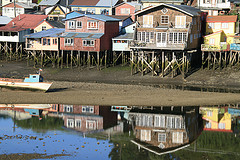Chiloé: the end of Christendom
The past six weeks in Patagonia, the Lakes District and Antarctica, while amazing, have all been pretty much about the same thing: nature. And the bases we’ve used to explore all that scenery – El Calafate, El Chaltén, Ushuaia and Bariloche – have all been touristy places unremarkable in and of themselves. So for our last sojourn into Chile, we chose a destination that we hoped would be a bit different and a bit more laid-back: the archipelago of Chiloé.
 During the Spanish conquest of the Americas and the subsequent religious conversion of the natives, Chiloé was referred to as el fin de la cristiandad – the end of Christendom. The locals built fine wooden churches but their religion fused Christianity with their ancient pagan beliefs, a practice that has continued down to the present to make Chiloé the most distinct part of Chile. In reality, however, a few days in Chiloé doesn’t really give you any sense of this fusion (one painting in one church aside), and it seems to me to be something that guidebooks and newspaper and/or magazine stories pick up and run with as an interesting way to introduce the region more than anything else. Regardless, Chiloé was certainly the most religious place we’ve been to since arriving on the continent in October, if the churches and other Christian paraphernalia are any indication. Sixteen of the wooden churches are UNESCO World Heritage listed sites, and we visited six of them in a span of two days (as well as one other that doesn’t have the UNESCO stamp), ranging from a completely unadorned and unpainted countryside church in Vilupulli to the half-neo-Gothic, half-neo-Classical edifice that dominates Castro, the region’s largest city. All are quite interesting and picturesque and, though they range from 100 to 250 years old, they all still dominate their respective small towns.
During the Spanish conquest of the Americas and the subsequent religious conversion of the natives, Chiloé was referred to as el fin de la cristiandad – the end of Christendom. The locals built fine wooden churches but their religion fused Christianity with their ancient pagan beliefs, a practice that has continued down to the present to make Chiloé the most distinct part of Chile. In reality, however, a few days in Chiloé doesn’t really give you any sense of this fusion (one painting in one church aside), and it seems to me to be something that guidebooks and newspaper and/or magazine stories pick up and run with as an interesting way to introduce the region more than anything else. Regardless, Chiloé was certainly the most religious place we’ve been to since arriving on the continent in October, if the churches and other Christian paraphernalia are any indication. Sixteen of the wooden churches are UNESCO World Heritage listed sites, and we visited six of them in a span of two days (as well as one other that doesn’t have the UNESCO stamp), ranging from a completely unadorned and unpainted countryside church in Vilupulli to the half-neo-Gothic, half-neo-Classical edifice that dominates Castro, the region’s largest city. All are quite interesting and picturesque and, though they range from 100 to 250 years old, they all still dominate their respective small towns.
The other unique aspect of Chiloé is its distinct food and drink, and we successfully experimented on both fronts. The latter included licor de oro, something more like a potion than a drink, and various chocolate or dulce de leche concoctions. The former is dominated by seafood, and while the chupe de mariscos (a kind of seafood bake with melted cheese on top) was my favourite, the curanto is the dish most worthy of description. When it arrived, shells from clams and absolutely enormous muscles protruded from our bowls, with potatoes, another type of starch and a further festival of meat including sausage, chicken and beef all lurking underneath. Once you shell the seafood, you then pour soup from a separate bowl over the whole thing (or at least that’s what we did), and then it’s ready to eat – very filling and very unusual, but not something I’d be in a rush to try again.
 Churches and food aside, we spent the rest of our time in Chiloé admiring the residential architecture of the various towns, including some stilt houses in Castro known as palafitos, watching CNN’s coverage of the devastating earthquake in Haiti and continuing an eternally favourite pastime of plotting our immediate future, which is beginning to take shape. It was a relaxing and enjoyable few days and we were glad we made the decision to go. Plus, the archipelago defied its reputation of being a misty, cloud-covered land and was sunny most of the time, which always helps.
Churches and food aside, we spent the rest of our time in Chiloé admiring the residential architecture of the various towns, including some stilt houses in Castro known as palafitos, watching CNN’s coverage of the devastating earthquake in Haiti and continuing an eternally favourite pastime of plotting our immediate future, which is beginning to take shape. It was a relaxing and enjoyable few days and we were glad we made the decision to go. Plus, the archipelago defied its reputation of being a misty, cloud-covered land and was sunny most of the time, which always helps.
We arrived back in Argentina yesterday and spent today preparing for the four-day, three-night (including side trips) ‘Paso de las Nubes’ trek that we begin tomorrow around Mt. Tronador. Hopefully it won’t rain, the vistas will be as spectacular as advertised, and our tent and battered sleeping mats have one more trek left in them.
Tags: Chile, Chiloé, churches, South America, weird food and drinks
